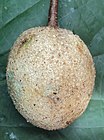Note: This is a project under development. The articles on this wiki are just being initiated and broadly incomplete. You can Help creating new pages.
Difference between revisions of "Crateva religiosa - Varuna"
(→References) |
(→List of Ayurvedic medicine in which the herb is used) |
||
| Line 48: | Line 48: | ||
==List of Ayurvedic medicine in which the herb is used== | ==List of Ayurvedic medicine in which the herb is used== | ||
| − | + | * [[Varanadi kashaya]] | |
| + | * [[Maha manjishtadhi kashaya]] | ||
| + | * [[Nyagrodhadi churna]] | ||
| + | * [[Abhaya lavana]] | ||
| + | <ref name="Ayurvedic preparations"/> | ||
==Where to get the saplings== | ==Where to get the saplings== | ||
Revision as of 14:17, 5 June 2019
Varuna, Crateva religiosa is a small spreading tree with trifoliate leaves that emit a pungent smell when bruised. This herb is in use since the time of the Vedas.
Contents
- 1 Uses
- 2 Parts Used
- 3 Chemical Composition
- 4 Common names
- 5 Properties
- 6 Habit
- 7 Identification
- 8 List of Ayurvedic medicine in which the herb is used
- 9 Where to get the saplings
- 10 Mode of Propagation
- 11 How to plant/cultivate
- 12 Commonly seen growing in areas
- 13 Photo Gallery
- 14 References
- 15 External Links
Uses
Improves digestion strength, Cardiac disorders, Paralysis, Blood disorders, Kidney stones, Headache ,Migraine. [1]
Parts Used
Chemical Composition
Common names
| Language | Common name |
|---|---|
| Kannada | bilapatri, hoddelenage, holenekki, mavalanga, mavilinga, narave, narumbala, narumbele, neervaala mara |
| Hindi | barna, vaivarno |
| Malayalam | killi, neervala, niramathalam, niravila, nirmatalam |
| Tamil | Adhicharam, adhimalam, narvala, mavilankai, mavilankam, mavilanku |
| Telugu | chinnaulimidi, magalingamu, maaredu, mogalingam |
| Marathi | NA |
| Gujarathi | NA |
| Punjabi | NA |
| Kashmiri | NA |
| Sanskrit | tikta-shaka, varuna, kumaraka, marutapaha |
| English | Sacred Barna, Garlic pear tree |
Properties
Reference: Dravya - Substance, Rasa - Taste, Guna - Qualities, Veerya - Potency, Vipaka - Post-digesion effect, Karma - Pharmacological activity, Prabhava - Therepeutics.
Dravya
Rasa
Tikta (Bitter), Kashaya (Astringent)
Guna
Laghu (Light), Ruksha (Dry)
Veerya
Ushna (Hot)
Vipaka
Katu (Pungent)
Karma
Vata and Kapha
Prabhava
Habit
Identification
Leaf
| Kind | Shape | Feature |
|---|---|---|
| Trifoliate | alternate | Leaves alternate, digitately trifoliate; rachis 4-12 cm long, slender, grooved above, glabrous; petiolule 4-7 mm long, slender; leaflets 10-20 x 3.5-6 cm, unequal, ovate, ovate-lanceolate or broadly elliptic, base acute, or subacute, apex acute or acuminate, margin entire, glabrous, coriaceous; lateral nerves 9-15 pairs, slender, parallel, prominent, intercostae reticulate, faint. |
Flower
| Type | Size | Color and composition | Stamen | More information |
|---|---|---|---|---|
| Bisexual | Terminal corymbs | White-yellow | many | pedicel to 5 cm long. Sepals 4, 3 mm long, free, oblong, adnate to the lobed disc. Petals 4, ca. 2 cm long, creamy white, often tinged with purple, long-clawed, obovate. Disc incurved, nectariferous. Stamens many, free, longer than the petals, inserted at the base of gynophore; anthers basifixed, filaments spreading. Gynophore 4-5 cm long at anthesis, slender; ovary superior, ellipsoid, 1-[2]-celled, ovules many; stigma sessile, capitate.Flowering and fruiting is from March to May |
Fruit
| Type | Size | Mass | Appearance | Seeds | More information |
|---|---|---|---|---|---|
| A berry | 4-5 x 2.5-3.5 cm | Fruit globose or ovoid, yellowish-grey, rind woody, scurfy | seeds brown, embedded in pulp. | {{{6}}} |
Other features
List of Ayurvedic medicine in which the herb is used
Where to get the saplings
Mode of Propagation
How to plant/cultivate
Seeds from ripe fruit have to be planted immediately as they lose viability quickly. Cuttings of semi-woody stems can also be planted. [5]
Commonly seen growing in areas
Photo Gallery
References
- ↑ Uses
- ↑ Vernacular names
- ↑ BOTANIC DESCRIPTION
- ↑ Cite error: Invalid
<ref>tag; no text was provided for refs namedAyurvedic preparations - ↑ Cultivation details
External Links
- Pages with reference errors
- Ayurvedic Herbs known to be helpful to treat Improves digestion strength
- Ayurvedic Herbs known to be helpful to treat Cardiac disorders
- Ayurvedic Herbs known to be helpful to treat Paralysis
- Ayurvedic Herbs known to be helpful to treat Blood disorders
- Ayurvedic Herbs known to be helpful to treat Kidney stones
- Ayurvedic Herbs known to be helpful to treat Headache
- Ayurvedic Herbs known to be helpful to treat ,Migraine
- Herbs with Root used in medicine
- Herbs with Leaves used in medicine
- Herbs with Stem used in medicine
- Herbs with Flowers used in medicine
- Herbs with common name in Kannada
- Herbs with common name in Hindi
- Herbs with common name in Malayalam
- Herbs with common name in Tamil
- Herbs with common name in Telugu
- Herbs with common name in Sanskrit
- Herbs with common name in English
- Habit - Medium sized tree
- Index of Plants which can be propagated by Seeds
- Index of Plants which can be propagated by Cuttings
- Herbs that are commonly seen in the region of Tropical area
- Herbs
- Trees
- Trifoliate
- Ayurvedic herbs that don't have seed photos
- Capparaceae





